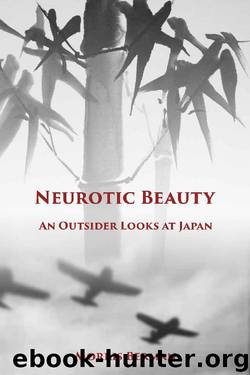Neurotic Beauty: An Outsider Looks at Japan by Morris Berman

Author:Morris Berman [Berman, Morris]
Language: eng
Format: epub
Publisher: Water Street Press
Published: 2017-01-17T22:00:00+00:00
Chapter 6 Vaguely, Crystal: The Americanization of Japan
A Japan once renowned for the Zen-like restraint of its aesthetics—its material simplicity, its tranquil bamboo gardens, its glassy ponds stocked with calming carp—now bathed itself in brassy neon lights and erupted in convulsions of exuberant decadence.
—Michael Zielenziger, Shutting Out the Sun
Postwar Japan was given life and nurtured by America. We were shown that the true meaning of life is meaninglessness….We were forced into a system that does not produce “adults.”
—Takashi Murakami, “Greetings, You Are Alive: Tokyo Pop Manifesto”(1999)
The cultural style developed by the victor just doesn’t seem to fit the loser.
—Takashi Murakami, “Superflat Trilogy”(2005)
We have come a long way since the Introduction, so I feel the need to recap some of the things I discussed in those pages, in particular the theme presented by Irving Kristol in Two Cheers for Capitalism. It is Kristol’s argument (to quote myself) that capitalism
imposes a great “psychic burden” upon the individual and the social order as well. Because it does not meet the individual’s “existential human needs,” he says, it creates a “spiritual malaise” that finally threatens the legitimacy of the social order. This is the crossroads at which Japan has arrived today…
One has to wonder, following our discussion in Chapter 5, whether Keiji Nishitani was as popular in his day as Kitarō Nishida and Hajime Tanabe were in theirs. In the go-go era of economic expansion following the Occupation, it is unclear to me that a philosopher arguing (and in a fairly dense and arcane style, to boot) that the American consumerist model was a spiritual dead end, and that “emptiness” or Absolute Nothingness offered a better life, would have much of an audience. The Japanese, after all, were falling over themselves to manufacture, and purchase, televisions and washing machines and just about everything else. And yet the American model finally did hit a wall in Japan, and the spiritual malaise referred to by Kristol and addressed by Nishitani did manage to present itself in no uncertain terms. This manifestation of nihility took a number of forms, and is still with Japan to this day. It is also the situation in which we all exist, in the advanced industrial nations—what the American historian Eugene Genovese called a condition of “affluent depravity”—which is why I believe that in this particular sense, we are all Japanese (the Japanese only more so). In any case, this manifestation is the subject of the present chapter.
Here is a rather painful example of what I am talking about. In the late nineties or shortly thereafter, the Japanologist John Nathan was talking to a middle school teacher from Okinawa, who said that she asked her eighth-graders to write down what they hoped to accomplish in their lives. Several of them began weeping in response to this. “I had the feeling,” she told Prof. Nathan, “that my question had brought them face to face with the reality that they had no sense of themselves, that the confusion of the times had robbed them of any idea of who they were, and [that] they were weeping with the misery of that.
Download
This site does not store any files on its server. We only index and link to content provided by other sites. Please contact the content providers to delete copyright contents if any and email us, we'll remove relevant links or contents immediately.
The Bhagavad Gita by Eknath Easwaran(1130)
First They Killed My Father: A Daughter of Cambodia Remembers by Loung Ung(912)
Comfort Woman by Maria Rosa Henson(616)
The Aquariums of Pyongyang: Ten Years in the North Korean Gulag by Chol-hwan Kang; Pierre Rigoulot(538)
The Diary of Lady Murasaki by Murasaki Shikibu(511)
The Hermit King: The Dangerous Game of Kim Jong Un by Chung Min Lee(505)
Gandhi & Churchill by Arthur Herman(484)
Bound Feet & Western Dress by Pang-Mei Chang(481)
Famous Samurai: Kamiizumi Nobutsuna by William de Lange(470)
Sengoku Jidai. Nobunaga, Hideyoshi, and Ieyasu: Three Unifiers of Japan by Danny Chaplin(461)
In Pharaoh's Army by Tobias Wolff(455)
Ramesses by Joyce Tyldesley(450)
When Broken Glass Floats: Growing Up Under the Khmer Rouge by Him Chanrithy(426)
The Accidental President: Harry S. Truman and the Four Months That Changed the World by A. J. Baime(419)
Ramesses: Egypt's Greatest Pharaoh by Joyce A. Tyldesley(392)
Return to Dragon Mountain by Spence Jonathan D(385)
Persona by Sato Hiroaki Inose Naoki(365)
Darach by RJ Scott(349)
Heaven's Wind by Stephen Earle(343)
